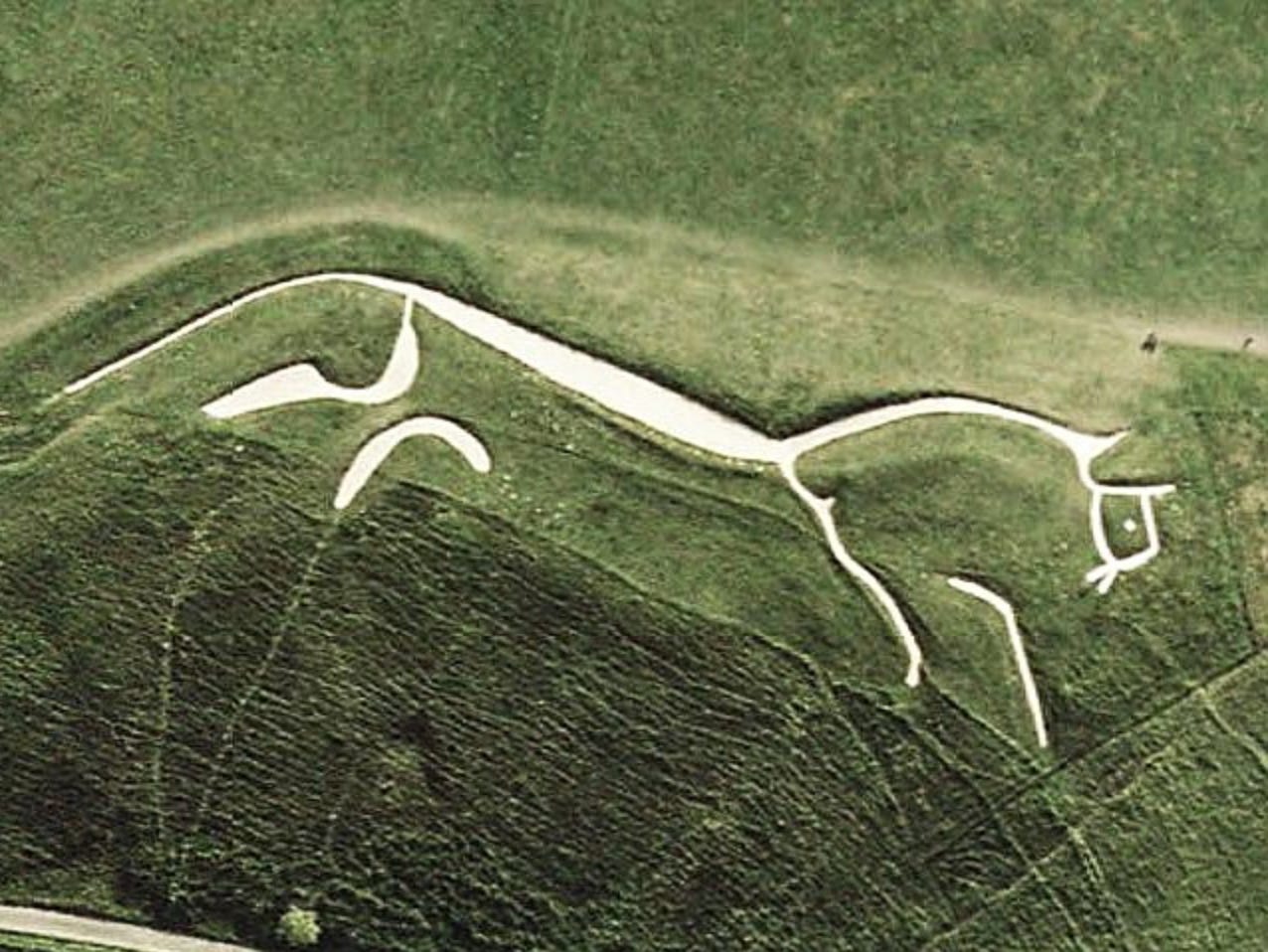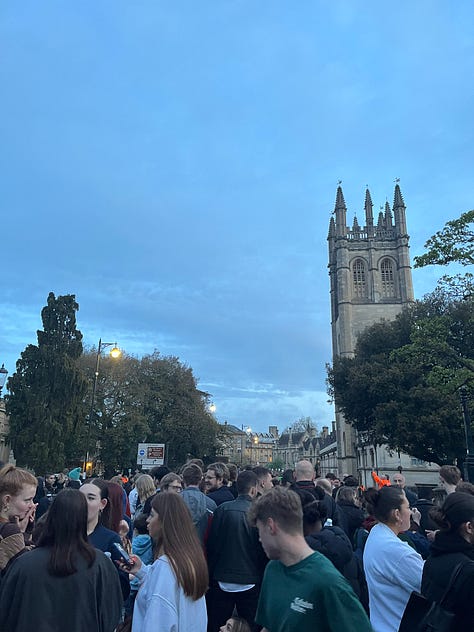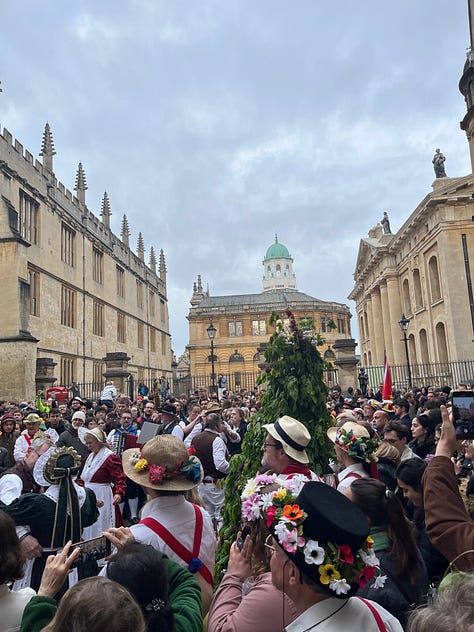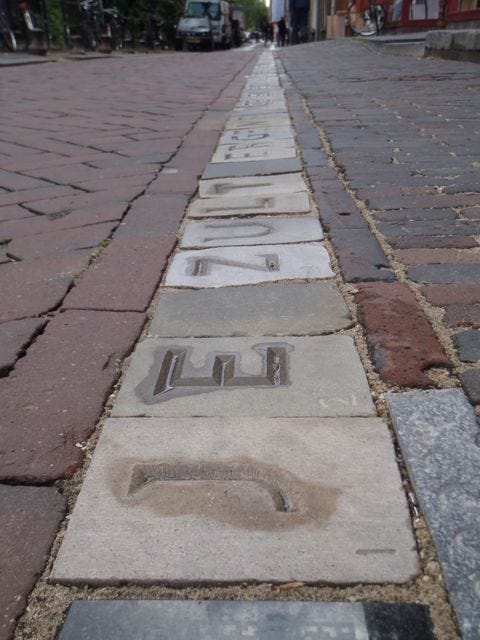The power of long-minded art
How art encourages the long view, and a viral review from Richard's Mum
Hello readers,
Following last week's insights into foresight, today’s update offers a taster from Part III of The Long View: specifically, how long-minded artistic projects expand our sense of time. Plus a surprisingly viral review of the book from Richard’s Mum, and a long-term ritual in Oxford…
Around 3,000 years ago, an ancient community living in what is now Oxfordshire in the UK decided to create a giant work of art. It’s not known why, but perhaps it was to please their gods, because it would be directed at the sky.

The people climbed up a small hillside, and began to dig and carve trenches, which they filled with crushed chalk. Later, it would be named the White Horse of Uffington.
Now overseen by the National Trust, the White Horse is chalked annually, an act of maintenance that stretches back to the Bronze Age. While its longevity is particularly striking, the White Horse of Uffington is just one example of such participatory and long-minded art.
The Future Library is another. Started in 2014 by the artist Katie Paterson, who was featured in the recent BBC deep time shorts, the books in this library will be printed on paper made from 1,000 trees growing in a special forest called Nordmaka, near Oslo in Norway and won’t be read until the year 2114.
Even greater in its temporal scope is Longplayer, a piece of music designed to play without repetition until the last day of 2999. Envisioned by Jem Finer, one of the founding members of The Pogues, his composition will stretch for a millennium. The installation can be heard at a lighthouse in London, with 234 Tibetan singing bowls used in live concerts to accompany the score, but there’s also an online livestream.
These artistic projects present us with an alternative timeview to that of our blinkered age. By engaging with them, we confront the asymmetry between past and future generations. The longevity and symbolic power of these projects depend, at least in part, on readers in 100 years and those eager to chalk the white horse. They are reliant upon future people, sustained engagement and symbolic upkeep.
The best long-minded art aims to persist into the future but also to engage present-day people such that they too seek a longer view. Through collective acts, these projects allow us to not only connect with our ancestors and descendants but with each other alive today.
For example, in the Dutch city of Utrecht, a poem is being written in the street letter by letter. Every Saturday at lunchtime, a stonemason in the city centre carves a new letter into a cubic block. They then places the new letter next to the last one, embedded in the street. It’s called The Letters of Utrecht, and the poem is currently about 100 metres (328 feet) long.
Every week, the number of people invested in the project and its continuation grows. When the stonemasons are finished, members of the public sometimes scrawl their names onto the sides with pen or correction fluid before it is laid into the ground. For €100, it’s also possible to donate a stone and attach a name permanently to the record by having it carved onto the side. As Richard writes in The Long View:
Utrecht, the White Horse, and many projects alike speak to art’s capacity to both transcend time and unite people across it - two of the aims running through The Long View.
Part III of the book expands on these projects and much more, drawing lessons from similarly enduring activities, rituals, and traditions that free us from the fetters of short-termist thinking.
In Part III, you will also read about:
two astronomers who waged war against pigeon faeces only to encounter something far more consequential…
a wandering wooden boulder
what it means to be a “deep civilisation”
and much more….
The goal of Part III is to show that change is possible. While it takes effort to discover the long view, there are examples of it strewn across many domains in life. Whether the insights come from learning about a group of eminent academics parading around an Oxford campus singing a song about ducks or from the ritual destruction and rebuilding of Shinto shrines, you’ll come to see that there are countless ways we can interface with timescales outside of our own lifespan.
May Morning in Oxford
By Xander Balwit



For the last 500 years, thousands of people have gathered on High Street underneath Magdalen Tower to listen to a Latin hymn and celebrate May Day.
This year, I had the pleasure of being one of the nearly 16,000 thousand visitors who gathered together in this ritual act of springtime revelry. Beginning at 6:00 am, a congregation of all-night carousers and drowsy early risers stand in silence while the Magdalen choir sings the Hymnus Eucharisticus. After the hymn is sung, the dean of divinity recites a prayer speaking to the season of rebirth and vitality. The prayer gives way to bells that accompany both those who straggle home to sleep and those who surge into the city centre for music, drink, and dancing.
Despite the party atmosphere and the early hour, I found myself able to connect to a sense of collective ritual and tradition. As I observed the gaudy plastic flowers against the worn cobblestones, I thought about the millions of people who have experienced what I was experiencing. While the background is different, as the sea of smartphones reminded me, the texture of the tradition much unchanged - the same hymn, the same customary ale, the same reflection on the holiday’s ancient roots.
Throughout the day that followed I found myself in conversation with fellow attendees, all rehashing our mornings and measuring them against each other. As my version of the event blended into others, they created a tapestry of experience far larger than my own.
This blending of time and enlarging of experience is characteristic of ritual. Far more than merely a collection of unique customs or behaviors, rituals grant us moments of communion with our fellow human beings across space and time.
Richard’s mum goes viral

Last week, Richard’s tweet featuring a review card left by his Mum in her local Waterstones went unexpectedly viral. The main account for Waterstones shared it, as did the actress Kathy Burke, and one person even made a copycat card to place at another branch. Here’s to supportive mums. :)
“A wonderful book - full of hope for the future” - Richard’s Mum
Richard is featured on Ours For The Making
Richard discusses The Long View on the YouTube channel Ours For The Making. Go here to learn about how we can become more long-minded in our day-to-day lives and build institutions, practices, and norms that take on a longer view.
A short letter inspired by The Long View in New Scientist
It has been a treat to see Long View-inspired ideas end up in Letters to the Editor. This reader recommends tree-planting as a way to exercise our long-mindedness.
Have you read The Long View?
If you’ve already read/listened to The Long View, and would recommend it to others, a review on Amazon or other retailers would be deeply deeply appreciated. Thank you!
The Long View is available for purchase! You can look for a copy at your local book shop or you can get it here from other retailers, as well as the e-book and Audible version (read by Richard!) If you’d like 25% off the cover price and live in the UK, visit the Headline shop, and use this code at checkout: LONGVIEW25
best wishes,
Richard & Xander - The Long View team
Previous editions of The Long View: A Field Guide







